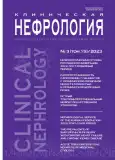Development of ideas about urolithiasis
- Authors: Subotyalov M.A.1,2
-
Affiliations:
- Novosibirsk State Pedagogical University
- Novosibirsk National Research State University
- Issue: Vol 15, No 3 (2023)
- Pages: 56-60
- Section: Literature Reviews
- Published: 17.12.2023
- URL: https://journals.eco-vector.com/2075-3594/article/view/624738
- DOI: https://doi.org/10.18565/nephrology.2023.3.56-60
- ID: 624738
Cite item
Abstract
The article presents the prerequisites, formation and development of ideas about urolithiasis. The purpose of this review was to analyze the basic ideas about the urolithiasis, starting from the era of the Ancient World and ending with studies of the Modern period. In preparing the text of this publication, articles in publications included in the RSCI, PubMed were used. The depth of the search for publications was 15 years, and a number of earlier works corresponding to the research topic were also included in the review. The results of the process of formation and development of ideas about the urolithiasis are presented. So, already in the ancient era, healers asked questions about the causes, the process of development of the urolithiasis. In the Middle Ages, the accumulation of empirical knowledge in this area continued. The understanding of the methods and means of treating urolithiasis was expanding and deepening. In modern times, the concept of the ICD received a more complete description. Risk factors and mechanisms for the development of this disease began to be studied. Today, research in this area continues.
Full Text
About the authors
Mikhail A. Subotyalov
Novosibirsk State Pedagogical University; Novosibirsk National Research State University
Author for correspondence.
Email: subotyalov@yandex.ru
Dr.Sci. (Med.), Associate Professor, Professor at the Department of Anatomy, Physiology and Life Safety, Associate Professor at the Department of Fundamental Medicine
Russian Federation, 28 Vilyuyskaya. st., Novosibirsk, 630126; NovosibirskReferences
- Subotyalov M., Druzhinin V., Sorokina T. Description of urolithiasis in the sources of traditional Ayurvedic medicine. J. Nephrol. 2013;26(22):218.
- Nenov D., Nenov V., Lazarov G., Tchepilev A. Treatment of renal stones in Bulgaria in ancient times ('Hissarya' baths). Am. J. Nephrol. 1999;19(2):163–64. doi: 10.1159/000013444.
- Dardioti V., Angelopoulos N., Hadjiconstantinou V. Renal diseases in the Hippocratic era. Am. J. Nephrol. 1997;17(3–4):214–16. doi: 10.1159/000169104.
- Poulakou-Rebelakou E., Rempelakos A., Tsiamis C., Dimopoulos C. "I will not cut, even for the stone": origins of urology in the Hippocratic Collection. Int. Braz. J. Urol. 2015;41(1):26–9. doi: 10.1590/S1677-5538.IBJU.2015.01.05.
- Bellinghieri G., Satta E., Savica V., et al. The management of kidney stones as suggested by Goeury-Duvivier. J. Ital. Nefrol. 2016;33(Suppl. 66):33.S66.20.
- Changizi Ashtiyani S., Cyrus A. Rhazes, a genius physician in diagnosis and treatment of kidney calculi in medical history. Iran. J. Kidney Dis. 2010;4(2):106–10.
- Faridi P., Roozbeh J., Mohagheghzadeh A. Ibn-Sina's life and contributions to medicinal therapies of kidney calculi. Iran. J. Kidney Dis. 2012;6(5):339–45.
- Gaeta R., Fornaciari A., Giuffra V. "Renal Calculi as Big as Eggs": Urolithiasis and Chronic Kidney Disease of Ludovico I, Marquis of Saluzzo (1406–1475). Urology. 2017;103:4–6. doi: 10.1016/j.urology.2017.02.017.
- Lokeshwar S.D., Randall V.A., Dykes T.E., et al. Dr. Alexander Randall III and the Discovery of Randall's Plaques. Urology. 2020;146:15–8. doi: 10.1016/j.urology.2020.09.023.
- De Santo N.G., Bisaccia C., Ricciardi B., et al. Disease of the kidney and of the urinary tract in De Medicina Methodica (Padua, 1611) of Prospero Alpini (1563–1616). J. Ital. Nefrol. 2016;33(Suppl. 66):33.S66.29.
- Riva M.A, Testa F., Cesana G., Castagna F. Pope Innocent XI's renal stones: an example of medical correspondence. Intern. Emerg. Med. 2018;13(2):307–8. doi: 10.1007/s11739-018-1800-7.
- Richet G. Nephrolithiasis at the turn of the 18th to 19th centuries: biochemical disturbances. A genuine cascade giving rise to clinical chemistry. Am. J. Nephrol. 2002;22(2–3):254–59. doi: 10.1159/000063770.
- Зубарев П.Н., Соловьев И.А. Иван Федорович Буш – основоположник Отечественной хирургии. У истоков медицины столицы Российской Империи: Материалы научно-практической конференции: Военно-медицинская академия имени С.М. Кирова. 2015. С. 40–2 [Zubarev P.N., Solov'ev I.A. Ivan Fyodorovich Bush is the founder of the Patriotic Surgery. U istokov meditsiny stolitsy Rossiiskoi Imperii: Materialy nauchno-prakticheskoi konferentsii: Voenno-Med. Akad. Im. S.M. Kirova. 2015. Р. 40–2 (In Russ.)].
- Андреев А.А., Остроушко А.А. Илья Васильевич Буяльский – русский анатом и хирург, академик Императорской академии художеств (к 230-летию со дня рождения). Вестн. экспериментальной и клинической хирургии. 2019;12(2):150. doi: 10.18499/2070-478X-2019-12-2-150. [Andreev A.A., Ostroushko A.A. Ilya Vasilievich Buyalsky – Russian anatomist and surgeon, academician of the Imperial Academy of Arts (on the occasion of the 230th anniversary of his birth). Vestn. Experiment. Сlin. Surg. 2019;12(2):150 (In Russ.)].
- Курыгин А.А., Семенов В.В., Алипов В.В. Академик Сергей Иванович Спасокукоцкий (1870–1943) (к 150-летию со дня рождения). Вестник хирургии имени И.И. Грекова. 2020;179(3):7–12. doi: 10.24884/0042-4625-2020-179-3-7-12 [Kurygin A.A., Semenov V.V., Alipov V.V. Academician Sergei Ivanovich Spasokukotsky (1870–1943) (to the 150th anniversary of his birth). Vestn. Surg. im. I.I. Grekova. 2020;179(3):7–12 (In Russ.)].
- Patel S.R, Nakada S.Y. The modern history and evolution of percutaneous nephrolithotomy. J. Endourol. 2015;29(2):153–57. doi: 10.1089/end.2014.0287.
- D'Arcy F.T, Lawrentschuk N., Manecksha R.P., Webb D.R. Renal track creation for percutaneous nephrolithotomy: the history and relevance of single stage dilation. Can. J. Urol. 2015;22(5):7978–83.
Supplementary files





